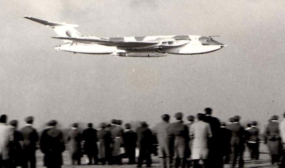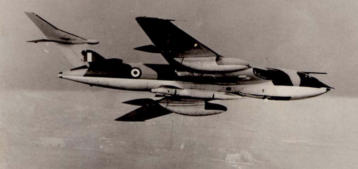It is difficult to write the history of XM715 without occasionally referring to the wider military aviation requirements and developments to appreciate why the aircraft evolved. It is not intended to give the history of the Victor- both Phil and Tony Butler (Handley Page Victor – the Crescent Winged Bomber) Roger Brooks (The Handley Page Victor) and Damien Burke (http://www.thunder-and-lightnings.co.uk/) have written excellent reference works on the development and history of the Victor.
After the Second World War, Godfrey Lee, the head of design at Handley Page, was fortunate to access German aviation design developments. He produced an innovative aircraft design for a long range jet bomber. In 1947 the Air Staff issued an Operational Requirement- OR230 later scaled back to OR229- for a high level, high-speed nuclear bomber capable of penetrating an enemy air defence and delivering a nuclear bomb.
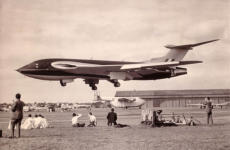 The delivery concept was still based on the bombing offensive in the Second World War, the requirement for the bomber to overfly the target to release the bomb. There were six responses to the design specification and eventually the Ministry of Aviation approved the production of three of the tenders. These included Godfrey Lee’s Handley Page HP80 – a follow on from their original HP72A. The seeds were sown and the evolution of the Victor began. The first Victor production order for 25 aircraft was made in June 1952 with the first flight of the prototype WB771 from Boscombe Down on 24th December 1952. In all 85 production aircraft and 2 prototypes were built.
The delivery concept was still based on the bombing offensive in the Second World War, the requirement for the bomber to overfly the target to release the bomb. There were six responses to the design specification and eventually the Ministry of Aviation approved the production of three of the tenders. These included Godfrey Lee’s Handley Page HP80 – a follow on from their original HP72A. The seeds were sown and the evolution of the Victor began. The first Victor production order for 25 aircraft was made in June 1952 with the first flight of the prototype WB771 from Boscombe Down on 24th December 1952. In all 85 production aircraft and 2 prototypes were built.
Shifting Sands
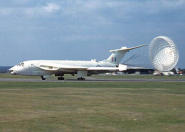 During the 1950s there were rapid advances in aviation, engine and weapon technology. In 1954 Handley Page commenced design work to further develop their bomber and by late 1955 they put forward proposals for an improved Victor, the B2. The first flight of a B2, XH668, was on 20th February 1959. The B2 was to fly at high speed and high altitude using electronic counter measures to penetrate Soviet air defences to the target to release its bomb.
During the 1950s there were rapid advances in aviation, engine and weapon technology. In 1954 Handley Page commenced design work to further develop their bomber and by late 1955 they put forward proposals for an improved Victor, the B2. The first flight of a B2, XH668, was on 20th February 1959. The B2 was to fly at high speed and high altitude using electronic counter measures to penetrate Soviet air defences to the target to release its bomb.
XM715 – As a Victor B2
In June 1960, the Air Ministry reduced the number of planned Victor B2s from 59 to 24. 715 was built in the 4th and final batch of 5 airframes which included 714-718. She was assembled at Radlett as a 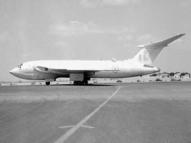 high-level free fall nuclear bomber to carry the Yellow Sun 2 nuclear weapon. She first flew with John Allam at Radlett on 31st December 1962. After a normal Production Flight Test Schedule of 4 flights, she was ready for delivery to the RAF in March 1963. It was normal for squadron crews to go to Radlett and pick up the bombers and on 4th March 1963 she was flown to RAF Wittering and taken on charge prior to her acceptance checks. She was allocated to No 100 Squadron in May 1963. The next internal transfer was on 16th April 1964 to the Victor Training Flight on No 232 OCU, where she provided the air conversion of bomber crews who had completed their ground school training at RAF Gaydon.
high-level free fall nuclear bomber to carry the Yellow Sun 2 nuclear weapon. She first flew with John Allam at Radlett on 31st December 1962. After a normal Production Flight Test Schedule of 4 flights, she was ready for delivery to the RAF in March 1963. It was normal for squadron crews to go to Radlett and pick up the bombers and on 4th March 1963 she was flown to RAF Wittering and taken on charge prior to her acceptance checks. She was allocated to No 100 Squadron in May 1963. The next internal transfer was on 16th April 1964 to the Victor Training Flight on No 232 OCU, where she provided the air conversion of bomber crews who had completed their ground school training at RAF Gaydon.
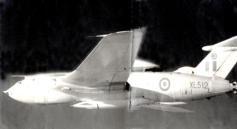 Various power plant options were considered with the usual Air Ministry interference and delays. What was clearly evident was that more powerful engines were required. However, the advances in Soviet air defences meant that delivering the bomb by over flying the target was becoming increasing vulnerable and the Air Ministry requested design developments to make the mission more survivable. Handley Page designed the Victor B2 to carry an air launched missile.
Various power plant options were considered with the usual Air Ministry interference and delays. What was clearly evident was that more powerful engines were required. However, the advances in Soviet air defences meant that delivering the bomb by over flying the target was becoming increasing vulnerable and the Air Ministry requested design developments to make the mission more survivable. Handley Page designed the Victor B2 to carry an air launched missile.
The rapid development of engines, weapons and air defences often meant a new aircraft design could be obsolescent soon after it entered service. The Air Ministry realised the vulnerability of the high altitude bomber and requested design changes to successfully penetrate the Soviet air defences.
715 remained at Wittering until 8 July 1964 when she returned to Radlett to take her turn on the Handley Page conversion programmes.
XM715- as a Victor B2R and B2 (BS)
Although 715 went through the retrofit programme at Radlett she never returned to service as a bomber at RAF Wittering. The Air Ministry reduced the order for Victor B2s from 59 to 34, a reduction of 25 aircraft. It is likely that 715 fell foul of the number crunch and was stored in the open at Radlett. However, she was brought up to full Retrofit and BS standards before being diverted to the SR conversion line.
XM715- as a Victor B2 (SR)
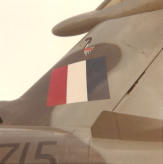 She remained at Radlett until the last 9 Victor B2 (BS) airframes were diverted on to the B2 (SR) line. The first B2 (SR) flew on 23 February 1965. The first flight of 715 as a B2 (SR) was on 24 May 1965 flown by M Thomson- airborne for 1 hour 5 minutes. There followed a Flight Test Profile of 6 sorties before delivery to No 543 Squadron at RAF Wyton on 23 June 1965. 715 was used extensively in the early days on the variety of reconnaissance tasks which included maritime radar reconnaissance, photo survey and air sampling.
She remained at Radlett until the last 9 Victor B2 (BS) airframes were diverted on to the B2 (SR) line. The first B2 (SR) flew on 23 February 1965. The first flight of 715 as a B2 (SR) was on 24 May 1965 flown by M Thomson- airborne for 1 hour 5 minutes. There followed a Flight Test Profile of 6 sorties before delivery to No 543 Squadron at RAF Wyton on 23 June 1965. 715 was used extensively in the early days on the variety of reconnaissance tasks which included maritime radar reconnaissance, photo survey and air sampling.
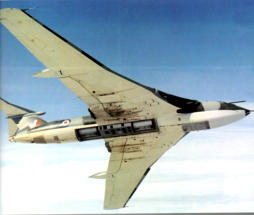 Using the experience gained in fitting radar reconnaissance equipment to a few B1s of the Radar Reconnaissance Flight at RAF Wyton, nine B2s were produced to a B2 (SR) standard. The Blue Steel mounts were not needed and the bomb bay was restored to a normal fit. The B2 (SR) bomb bay had three stations to attach stores. These could be a mixture of fuel tanks, camera crates or the night photoflash flares.
Using the experience gained in fitting radar reconnaissance equipment to a few B1s of the Radar Reconnaissance Flight at RAF Wyton, nine B2s were produced to a B2 (SR) standard. The Blue Steel mounts were not needed and the bomb bay was restored to a normal fit. The B2 (SR) bomb bay had three stations to attach stores. These could be a mixture of fuel tanks, camera crates or the night photoflash flares.
A normal training fit would be one fuel tank and two camera crates, each  crate able to carry a variety of eight cameras, vertical F49 for survey work, oblique F96 or night capable F89 with different film types: colour, false colour, infra-red or ultra-violet
crate able to carry a variety of eight cameras, vertical F49 for survey work, oblique F96 or night capable F89 with different film types: colour, false colour, infra-red or ultra-violet 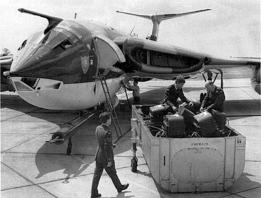 sensitive, according to task. A survey sortie fit would be two fuel tanks and a single camera crate. When needed for night photographic training on the El Adem range, one camera crate and a photoflash crate of thirty-six magnesium flares would be fitted. It was everyone’s dream to get a hang up with the first photoflash as the emergency drill was to jettison all thirty-six in one go, certainly spoiling the locals’ night vision for a while. It was intended that these airframes could be converted back to B2 (BS) standard if needed.
sensitive, according to task. A survey sortie fit would be two fuel tanks and a single camera crate. When needed for night photographic training on the El Adem range, one camera crate and a photoflash crate of thirty-six magnesium flares would be fitted. It was everyone’s dream to get a hang up with the first photoflash as the emergency drill was to jettison all thirty-six in one go, certainly spoiling the locals’ night vision for a while. It was intended that these airframes could be converted back to B2 (BS) standard if needed.
Additionally, engineers from Aldermaston could fit the reconnaissance aircraft with air sampling equipment. Both the French and Chinese governments were conducting atmospheric nuclear tests and the B2 (SR) was frequently tasked to collect airborne radioactive dust samples.
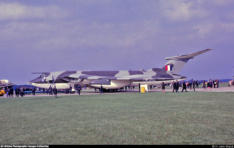 However, in 1967, during a routine Non Destructive Test (NDT) to monitor aircraft fatigue, crack damage to the lower spar 3 rib 54 Club Foot in the port wing root was discovered. It proved irreparable from service engineering resources and 715 was struck off charge in December 1967 and flown to Radlett for storage on 19 December 1967.
However, in 1967, during a routine Non Destructive Test (NDT) to monitor aircraft fatigue, crack damage to the lower spar 3 rib 54 Club Foot in the port wing root was discovered. It proved irreparable from service engineering resources and 715 was struck off charge in December 1967 and flown to Radlett for storage on 19 December 1967.
The Dilemma of Handley Page
By December 1968 the last B2 (BS) squadron of the Wittering wing had disbanded and all the aircraft had been returned to Radlett. Handley Page had produced proposals to modify the Victor B2 into K2 tankers. Initially, it had considered 715 as the Victor K2 prototype but eventually conceded that the engineering repair work required was too extensive to meet its proposed tanker conversion programme timetable. By this time Handley Page was in trouble.
Hawker Siddeley Aviation- the New Dawn
The contract for Victor B2 conversions to K2 tankers was awarded to Hawker Siddeley (HSA) at Woodford. The stored aircraft were prepared and the Handley Page crews began the low level ferries from Radlett to Woodford for conversion between April and July 1970. 715 was given a one flight only clearance and John Allam, B Grieve and Ray Funnell flew for 35 minutes transiting at low level from Radlett to Woodford on 10 June 1970 for repair and conversion. Woodford completed twenty-four K2 conversions and the first K2 flight was made on 1 March 1972.
XM715 – as a Victor K2
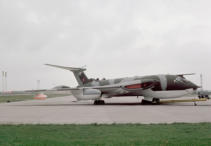 715 commenced her strip down on 17th January 1972. Engine runs were completed by 11th March 1975 and 715 first flew as a K2 on 10th April 1975. The flight, flown by Harry Fisher, lasted 2 hours 30 minutes. Following a further 5 flight test sortie, 715, as the ninth K2 conversion,
715 commenced her strip down on 17th January 1972. Engine runs were completed by 11th March 1975 and 715 first flew as a K2 on 10th April 1975. The flight, flown by Harry Fisher, lasted 2 hours 30 minutes. Following a further 5 flight test sortie, 715, as the ninth K2 conversion, 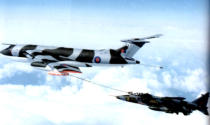 was delivered to No 232 OCU at Marham on 12th May 1975 by Charles Masefield. She had logged few flying hours because of the wing root damage that grounded her in 1967. 715 spent most of her later life with 55 Squadron at RAF Marham until service retirement in 1993.
was delivered to No 232 OCU at Marham on 12th May 1975 by Charles Masefield. She had logged few flying hours because of the wing root damage that grounded her in 1967. 715 spent most of her later life with 55 Squadron at RAF Marham until service retirement in 1993.
The history would not be complete without covering the 2 major conflicts that involved the Victor K2- Operation Corporate – the Falklands War- and Operation Granby- the first Gulf War.
Operation Corporate- The Falklands War (2nd April – 14th June 1982) SORTIES
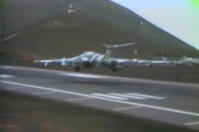 715, captained by Flight Lieutenant Frank Milligan, was in the first wave of tankers that deployed to Ascension Island on 18th April 1982 landing fifth and last in the stream that day. She flew in support of the Maritime Radar Reconnaissance missions to South Georgia in Fleet Support- 20th, 22nd/23rd and 24/25th April and the first Black Buck raids.
715, captained by Flight Lieutenant Frank Milligan, was in the first wave of tankers that deployed to Ascension Island on 18th April 1982 landing fifth and last in the stream that day. She flew in support of the Maritime Radar Reconnaissance missions to South Georgia in Fleet Support- 20th, 22nd/23rd and 24/25th April and the first Black Buck raids.
On 26th April 715 returned to the UK staging through Dakar for fuel. This rotation of aircraft became common due to the limited parking ramp space on Wideawake Airfield. As task priorities changed Victors, Vulcans and Nimrods would depart Ascension to free up sufficient parking space for the next series of operations. Whilst back at Marham in early May 715 supported the deployment of Harrier reinforcement aircraft, Royal Navy Sea Harriers (SHAR) and RAF Harrier GR3s, to Ascension. 715 provided the refuelling support in the South Western Approaches to the SHAR before returning to Marham. 715 went further south with the GR3s and landed at Banjul before returning to Marham.
On 13th May she provided air to air refuelling support for Vulcan XM672 and both landed at Ascension. She was quickly back in the war zone and Martin Todd flew 715 as the primary refuelling Victor to support the first operational Nimrod 2P refuelled mission on 15th May. Nimrod support missions were code named Operation Tuppence- this was Tuppence 9. Although 715 was airborne for 7 hours 40 minutes the Nimrod was airborne for over 19 hours!
Interspersed with the missions in support of the Vulcan and Nimrods, an equally important role was that of refuelling C-130 Hercules transports engaged in priority air drops to the South Atlantic Task Group. Operation Cadbury was the code name for these Hercules ultra-long duration flights. On 2nd June 715 was flown by Bob Tuxford on Operation Vera, (Cadbury 9) an air drop to the Task Force as No 2 in a formation of 3 Victor K2s refuelling a single C-130. 715 was airborne for 10 hours 15 minutes, the Hercules round trip was considerably longer.
715 also participated in Black Buck 7, the last Vulcan bombing mission on 12th June.
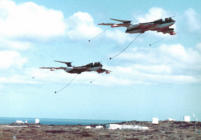 On 13th June 1982 715 flown by John Elliott took off from Ascension in company with Neil MacDougall in Vulcan XM597 to provide refuelling support to transit direct to RAF Waddington. The Vulcan had returned to Ascension from Rio after the failed fuel transfer during the recovery of Black Buck 6 on 3rd June. 715 landed at Dakar for a quick turn round before continuing on to RAF Marham. Whilst in the UK she flew extensively, training sorties mounted to convert pilots of Nimrods, Hercules and Victors to the receiving role. When Operation Corporate finished she played her part over the next 2 and half years with regular detachments to Ascension in support of the Hercules Air Bridge between Ascension and the Falklands.
On 13th June 1982 715 flown by John Elliott took off from Ascension in company with Neil MacDougall in Vulcan XM597 to provide refuelling support to transit direct to RAF Waddington. The Vulcan had returned to Ascension from Rio after the failed fuel transfer during the recovery of Black Buck 6 on 3rd June. 715 landed at Dakar for a quick turn round before continuing on to RAF Marham. Whilst in the UK she flew extensively, training sorties mounted to convert pilots of Nimrods, Hercules and Victors to the receiving role. When Operation Corporate finished she played her part over the next 2 and half years with regular detachments to Ascension in support of the Hercules Air Bridge between Ascension and the Falklands.
Operation Granby – Desert Storm, Gulf War 1 SORTIES
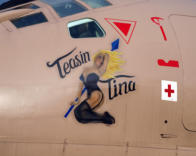 As fatigue concerns grew in the early 1990s, the tanker wing at Marham reduced to a single squadron, No 55 Squadron. On the eve of retirement,
As fatigue concerns grew in the early 1990s, the tanker wing at Marham reduced to a single squadron, No 55 Squadron. On the eve of retirement,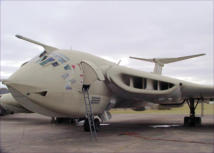 the first Victor K2s of No 55 Squadron deployed to Bahrain on 15 December 1990 in support of coalition sorties into Kuwait and Iraq. Of the ten Victors involved in Granby, six gained colourful nose art – 715 was designated “Teasin’ Tina”.
the first Victor K2s of No 55 Squadron deployed to Bahrain on 15 December 1990 in support of coalition sorties into Kuwait and Iraq. Of the ten Victors involved in Granby, six gained colourful nose art – 715 was designated “Teasin’ Tina”.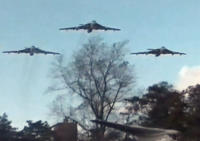 The Victor force again distinguished themselves in the Gulf, with 299 sorties tasked and 299 flown – a 100% availability rate not matched by any other RAF aircraft. Teasin’ Tina is credited with 38 refuelling missions which were represented as black petrol pumps to the rear of the crew door. On 18th March 1991 715 returned to Marham via a short detachment at Punta Raisi ( Palermo) refuelling RAF combat aircraft returning to the UK. On board was the Squadron Commander, Wing Commander David Williams. Despite this brief spot i n the limelight, the Victors were reaching the end of their lives. The last tanker retired on 15 October 1993.
The Victor force again distinguished themselves in the Gulf, with 299 sorties tasked and 299 flown – a 100% availability rate not matched by any other RAF aircraft. Teasin’ Tina is credited with 38 refuelling missions which were represented as black petrol pumps to the rear of the crew door. On 18th March 1991 715 returned to Marham via a short detachment at Punta Raisi ( Palermo) refuelling RAF combat aircraft returning to the UK. On board was the Squadron Commander, Wing Commander David Williams. Despite this brief spot i n the limelight, the Victors were reaching the end of their lives. The last tanker retired on 15 October 1993.
Retirement
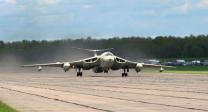 In 1993 the Walton family bought 715 from the MoD. 715 flew currency sorties – probably the crews on the Victor Disposal Flight – on the 3rd, 9th and 11th November. She was flown to Bruntingthorpe on the 19th November 1993 to join the extensive collection of Cold War Jets. The crew used the callsign “Meldrew 1” for the delivery referring to the “one foot in the grave” and there is nose art on the starboard side of the cockpit depicting the event. A small team of enthusiasts maintained her, initially Malcolm Lawrence and then Justin Morgan. 715 was always prepped to take part in the Cold War Jet Days, but sometimes technical
In 1993 the Walton family bought 715 from the MoD. 715 flew currency sorties – probably the crews on the Victor Disposal Flight – on the 3rd, 9th and 11th November. She was flown to Bruntingthorpe on the 19th November 1993 to join the extensive collection of Cold War Jets. The crew used the callsign “Meldrew 1” for the delivery referring to the “one foot in the grave” and there is nose art on the starboard side of the cockpit depicting the event. A small team of enthusiasts maintained her, initially Malcolm Lawrence and then Justin Morgan. 715 was always prepped to take part in the Cold War Jet Days, but sometimes technical 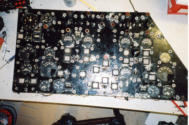 problems intervened. It was difficult to get ground power on the aircraft because of the ingress of water that subsequently froze and damaged the main electrical control and management system. In 2006 Terry Stephenson took on the task of engineering management of 715. He spent many hours assimilating the aircraft Air Publications, removed vital components,
problems intervened. It was difficult to get ground power on the aircraft because of the ingress of water that subsequently froze and damaged the main electrical control and management system. In 2006 Terry Stephenson took on the task of engineering management of 715. He spent many hours assimilating the aircraft Air Publications, removed vital components, 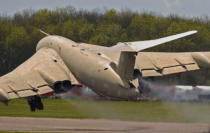 including the electrical control panel ( BF) taking them home and gradually
including the electrical control panel ( BF) taking them home and gradually 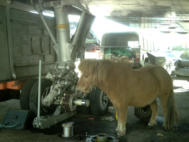 restoring them. Where aircraft parts were unavailable, he improvised. Terry and his team achieved the most difficult engineering challenge and brought 715 back to life. Since 2006, 715 has not
restoring them. Where aircraft parts were unavailable, he improvised. Terry and his team achieved the most difficult engineering challenge and brought 715 back to life. Since 2006, 715 has not 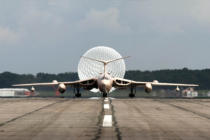 missed a public demonstration. One aborted take off run resulted in an inadvertent flight by Bob Prothero and Terry Stephenson on 3rd May 2009, the short flight at 100 feet thus became the last Victor flight ever. In 2012 she completed three public demonstrations of the aborted take off for the aviation enthusiasts who attend the Bruntingthorpe Cold War Jet Open Days
missed a public demonstration. One aborted take off run resulted in an inadvertent flight by Bob Prothero and Terry Stephenson on 3rd May 2009, the short flight at 100 feet thus became the last Victor flight ever. In 2012 she completed three public demonstrations of the aborted take off for the aviation enthusiasts who attend the Bruntingthorpe Cold War Jet Open Days
XM715 Synopsis
